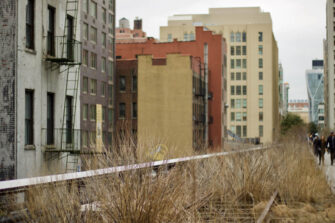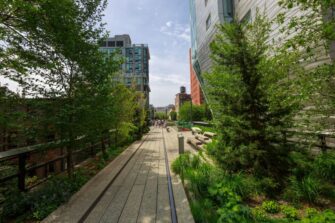The High Line Personal Injury Attorney

The High Line is New York City’s most unique park. Created on a former freight railroad line elevated above the west side of Manhattan, it runs from 1.45 miles from the Jacob J. Javits Convention Center at 34th Street to the northern edge of Chelsea at Gansevoort Street.
Now an icon of contemporary landscape architecture, this greenspace features a path that leads visitors above rooftops offering views of the skyline to 10th Avenue, as well as the Hudson River and the Statue of Liberty. The landscape includes wildflowers, greenery and outdoor art installations.
Key Features of the High Line
Table of Contents
The High Line was originally built as part of a West Side improvement infrastructure project that removed freight trains from the city streets and lifted them 30 feet in the air. New York Central Railroad delivered agricultural goods and food on the tracks from the 1930s until 1980.
The design is a collaboration between James Corner Field Operations, Diller Scofidio + Renfro, and planting designer Piet Oudolf. They chose more than 350 species of perennials, grasses, shrubs, vines and trees, all known for hardiness, sustainability, and variations in color and texture. Some of the original railroad tracks are integrated into the planting beds, as well as embedded into the walkway in a two-block-long thicket of dogwoods, roses, hollies and bottlebrush buckeye.
The High Line transformed an area where the tracks were severed and demolished south of Gansevoort Street into a dramatic balcony. Two passages at West 14th Street and between West 15th and West 16th Streets are partly enclosed for art and public programs. Food carts and an open-air café operate in the second passage during the warmer months.
The park includes a block-long lawn for picnics and summer programs; a grated metal pathway for walking through magnolia, sassafras and serviceberry trees at canopy level; and a pathway with lounge chairs and a water feature where visitors can dip their toes in the spring and summer. The park also has a children’s play area and whimsical touches such as periscopes and a “gopher hole” that allows someone to pop up into a planting bed.
History of the High Line
 1934: Freight trains run on the future site of the High Line, carrying goods to and from New York City’s Meatpacking District.
1934: Freight trains run on the future site of the High Line, carrying goods to and from New York City’s Meatpacking District.
1980: Because of growth in the interstate trucking industry, the last train runs on the High Line. It carries three carloads of frozen turkeys.
1999: The nonprofit Friends of the High Line is founded by neighborhood residents to preserve the track and reuse it as open public space.
2002 to 2003: Planning framework begins.
2004: Friends of the High Line and the City of New York select a landscape architecture firm and a planting designer to create the park.
2005: CSX Transportation donates the track to the city.
2006: Groundbreaking occurs on the first section of the park.
2009: The first section of the High Line, stretching from Gansevoort Street in the Meatpacking District to West 20th Street, opens to the public.
2011: A second section of the High Line opens, stretching from West 20th Street to West 30th Street.
2014: The third and northernmost section of the High Line opens, extending the park to West 34th Street around Hudson Yards, a mixed commercial, residential and retail space.
Location & Tourism
The High Line stretches from Gansevoort and Washington streets to West 34th Street and 12th Avenue. It is open daily from 7 a.m. to 7 p.m. in winter, until 10 p.m. in spring and fall, and until 11 p.m. in summer. It can be reached through 11 entrances, five of which are accessible to people with disabilities. Admission is free. The park has two public restrooms and a gift shop open from April through October.
Interesting Facts About the High Line
- A similar project in Paris inspired the design, as did the grass, trees and other plants that grew on the elevated tracks during their disuse.
- The park functions like a green roof, with porous pathways that contain open joints so that water drains between planks and waters planting beds, reducing the amount of storm water runoff.
- More than 120 artists from around the world have exhibited work on the High Line, including video projections, billboards and performances.
- The High Line sponsors more than 450 programs and activities each year to invite visitors to enjoy the space.
- As of July 2014, more than 20 million people had visited the High Line.
- Nine seasonal food vendors have served more than 36,000 tacos and 76,000 gelatos at the park since the High Line opened.
- Because of the elevation and design, smoking, bicycles, dogs, skateboards, skates and recreational scooters are prohibited.
Directions to Belluck Law from the High Line
Belluck Law’s NYC law office is located in Midtown at 546 Fifth Ave., 5th Floor, New York NY 10036. From the High Line’s northernmost point, head southeast on West 34th Street toward 11th Avenue. Turn left onto 10th Avenue. Turn right onto West 46th Street, then right onto Fifth Avenue. Our office also is accessible via the X30 bus from the Lincoln Tunnel approach near the Javits Center to West 42nd Street at Fifth Avenue.
CONTACT OUR NEW YORK INJURY LAW FIRM TODAY
At Belluck Law, LLP, our New York injury lawyer have been strongly fighting for the rights of individuals and families throughout New York City for more than two decades. Contact us today to know more.